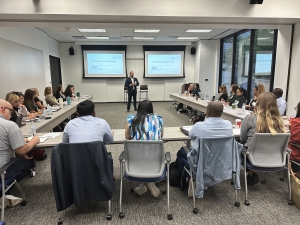PESA brought together more than 20 companies to follow up on previous HR townhall teleconferences sharing updated best practices for responding to the pandemic. PESA Advisory Board Member Bonnie Houston, Chief Administrative Officer, NOV, facilitated the townhall and opened the discussion with a review of responses to questions previously posed to the group.
401k Enhancements and CARES Act
With the finances of so many families stressed, companies are examining their 401k policies for ways to help. A majority of companies have opted into provisions created by the CARES act.
Some companies are allowing employees to postpone loan payments when affected by COVID-19, but others have not yet taken that action. The group anticipates increased 401k activity from employees in the coming weeks. Most companies have paused 401k matching and are waiting to see how the current situation progresses before scheduling a resumption.
COVID-19 Coverage
All companies are covering COVID-19 testing 100%, but practices vary when it comes to covering treatment. Approximately half are offering full coverage while others are providing coverage with the usual co-payments and deductibles required by their health insurance. Houston suggested the group watch for a point when testing begins to decline because insurance companies may designate further tests as not essential.
One company said it’s covering COVID-19 treatment at 100% for April and May and will reevaluate coverage based on circumstance. The company wanted to demonstrate to workers that their health and safety is important to the company. This company is considering extending coverage as part of plans to return to work.
Return to Work
As states and local jurisdictions move towards re-starting the economy, companies are making plans to bring employees back to work. Among the ideas being considered:
- Returning a quarter of the workforce to the job while taking new precautionary measures such as temperature checks, reconfigured work areas, and weighing factors such as school-age children or high-risk family members.
- Making case-by-case decisions based on facility needs.
- Asking managers to take the lead in developing plans for their team’s needs.
Managers and decision-makers are relying on CDC guidelines as they develop plans. All companies will adhere to social distancing recommendations where possible and require masks and other protective gear where it’s not. Working from home will remain in place for some companies and units.
“The way we operated pre-COVID will not be the way we operate for professional office staff going forward,” said one participant on the call. “Seeing how effective the workforce has been while working remotely, there is no need to have that many people sitting in one building. Our awareness and flexibility has widened and we will take getting back into the office very slowly.”
Communication of expectations is critical because of the rapidly changing environment. Managers are playing the key role of keeping employees informed and relaying concerns to executives. Companies are encouraging employees to contact their managers or HR rep to request special accommodations or if they or a family member are part of high-risk group.
Companies are also using health questionnaires to evaluate risks associated with specific employees. HIPAA rules are being strictly followed to ensure confidentiality. Other companies are asking employees these evaluation questions directly. One is using an app for employees to answer the questions via phone on a daily basis and then directs them to appropriate company staff if there’s a potential issue.
Workforce Reductions
The group also touched upon different factors associated with reductions in workforce or furloughs. While some companies have avoided reductions thus far, those who have either do not have enhanced benefit coverage or have made employees responsible for paying their portion of the premium.
One company has extended benefit enhancements for two months post-employment and another wants to enhance tax savings to both employee and company via unemployment. It cannot offer severance packages as large as it has in the past.
Most companies are still offering severance or something similar to support transition during the reductions while providing guidance for unemployment. The group is finding that going through the unemployment process is easier than earlier reported and some have direct contacts to provide faster assistance.
The WARN Act has not yet become applicable to most of the group but a few have begun announcements.
For the actual reduction process, most companies have used Microsoft Teams or other video conferencing options to include HR managers. They’re also providing prepaid packaging materials to return company property. For release documents, companies are using DocuSign or the “sign” option in Adobe Acrobat.
Supplies & PPE
Companies on the call also noted finding that, despite the rocky start, obtaining PPE and supplies becomes easier in recent weeks.
PESA will continue to hold townhalls and compile the various individual, local, state and federal resources for these HR discussions. For more information, contact Director Membership Services Carolynn Henriquez.




